BIOGRAPHY: Page 8
After the fall of Utopia, Nate Grey retired into obscurity for a time, without associating with any of the mutant factions. Nate learned that (in spite of all the changes he had been through) Sinister’s genetic timer was still active – he would soon die before reaching his 21st birthday. Through 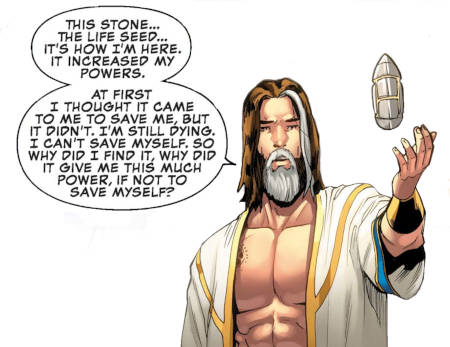 unexplained circumstances, a Lifeseed found its way into Nate’s possession. It was a Deathseed that empowered Apocalypse (and those like him) to serve as evolutionary gardeners for the mutant race, but this Lifeseed was its opposite. Nate absorbed the power of the Lifeseed and received vastly increased powers, exceeding Omega-class. Unfortunately, it did nothing to alleviate the fact that he was dying. With unfathomable power at his fingertips and limited time to use it, the X-Man started to consider what his legacy to the world would be.
unexplained circumstances, a Lifeseed found its way into Nate’s possession. It was a Deathseed that empowered Apocalypse (and those like him) to serve as evolutionary gardeners for the mutant race, but this Lifeseed was its opposite. Nate absorbed the power of the Lifeseed and received vastly increased powers, exceeding Omega-class. Unfortunately, it did nothing to alleviate the fact that he was dying. With unfathomable power at his fingertips and limited time to use it, the X-Man started to consider what his legacy to the world would be.
Whether it was the heady influence of the Lifeseed or his own ego and temperament, Nate started to see the world as fundamentally broken and only he could fix it. He identified many genuine problems, such as border disputes, corporate greed, environmental collapse and even man’s eternal inhumanity towards man. To begin addressing these problems, he assembled a “council” of advisors. The X-Man considered it a sign of his great humility to admit he didn’t have all the answers to the world’s problems, but he also saw no problem in abducting people against their will and forcing their opinions from them. Nate captured and restrained Kitty Pryde (leader and voice of the X-Men), Senator Ashton Allen (an active anti-mutant politician) and Apocalypse himself (a mutant supremacist and a reminder of all Nate had lost in life).
In order to carry out his will, the X-Man patterned his own Horsemen of Salvation after Apocalypse’s past henchmen. Again, Nate saw no problem in abducting servants, telepathically 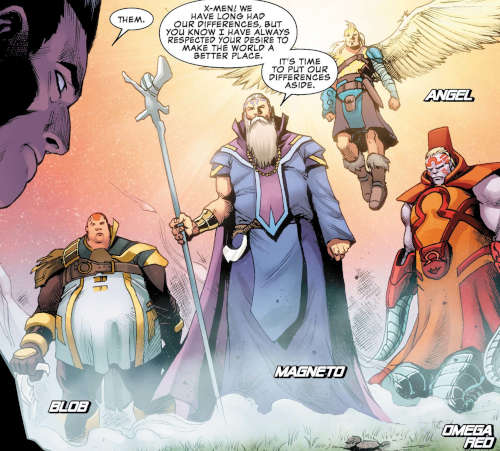 reprogramming them to feel absolute loyalty to his cause, and augmenting their powers just as the Lifeseed augmented his own. The X-Man chose Angel, Magneto, Omega Red and Blob to be his Horsemen of Life, Peace, Wellness and Bounty. These minions would prove necessary, for not only did the X-Men choose to fight for the status quo, but also the Omega mutant Legion took issue with Nate Grey’s actions. It was Legion’s time travels that first created the divergent timeline of the Age of Apocalypse, so he felt responsible for Nate’s existence. Never the most stable of individuals, though, Legion tried to hunt Nate down by projecting his powered personalities into the dupes of Jamie Madrox or other people, which only tended to create chaos.
reprogramming them to feel absolute loyalty to his cause, and augmenting their powers just as the Lifeseed augmented his own. The X-Man chose Angel, Magneto, Omega Red and Blob to be his Horsemen of Life, Peace, Wellness and Bounty. These minions would prove necessary, for not only did the X-Men choose to fight for the status quo, but also the Omega mutant Legion took issue with Nate Grey’s actions. It was Legion’s time travels that first created the divergent timeline of the Age of Apocalypse, so he felt responsible for Nate’s existence. Never the most stable of individuals, though, Legion tried to hunt Nate down by projecting his powered personalities into the dupes of Jamie Madrox or other people, which only tended to create chaos.
Seeing the X-Men as an unfortunate obstacle to his great works, the X-Man instructed his Horsemen to visit the Xavier Institute. With reluctance and empathy, the Horseman of “Peace” formerly called Magneto destroyed the X-Mansion in an attempt to kill Legion, Madrox and all the X-Men inside. Only Armor’s psionic exoskeleton and a few telepathic illusions kept the Horsemen from detecting their failure. With the X-Men out of the way, Nate felt prepared to announce telepathically his efforts to the world. He declared himself the Second Coming and promised to 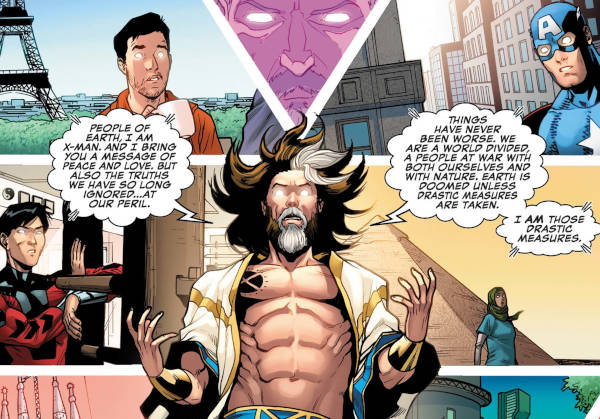 reshape the world in seven days to bring forth peace in our time. Everyone only needed to stay out of his way and rejoice.
reshape the world in seven days to bring forth peace in our time. Everyone only needed to stay out of his way and rejoice.
The X-Man sent forth Life and Peace to end war, while Bounty and Wellness would put a stop to the rape of the natural world. This was no grand plan in action, however. Nate was merely reacting to things he thought were wrong in the first way that came to mind. When speaking to his “council,” Nate got the notion from Apocalypse that he should cleanse the Earth of “false gods” that might distract people from conforming to his ideas. On a whim, he then reached out and erased from this world holy sites like the Vatican, Mecca and Thiruvananthapuram, because it seemed like a good idea in the moment. The X-Man was taking action, but he clearly had not considered the long-term or even medium-term consequences of his efforts.
After the X-Men freed Archangel from Nate’s control, they located his temple on Quadra Island off the coast of British Columbia. Jean Grey led the X-Men in trying to appeal to Nate’s humanity, but he rejected the idea that their biological bond gave her any true connection to him. He believed whatever death and chaos his actions were causing now would be justified when he ushered in a 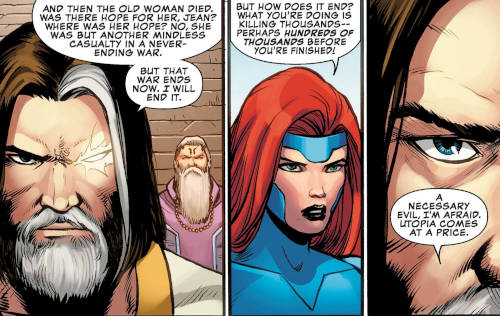 new utopia. A one-sided fight broke out between the X-Man and the X-Men, which was only interrupted when Armor and her student reserves arrived with Legion. Hisako was willing to talk, and Nate opened up for the first time about his death sentence. Hisako’s earnest and youthful questions got through Nate’s guard enough that he seemed to hesitate, but Legion then used that moment to strike.
new utopia. A one-sided fight broke out between the X-Man and the X-Men, which was only interrupted when Armor and her student reserves arrived with Legion. Hisako was willing to talk, and Nate opened up for the first time about his death sentence. Hisako’s earnest and youthful questions got through Nate’s guard enough that he seemed to hesitate, but Legion then used that moment to strike.
Nate Grey seemingly wound up back in the Age of Apocalypse, his powers gone, along with Armor, Rockslide, Pixie and Glob. They believed Legion had transported them through dimensions, but David Haller had actually created a pocket reality inside his mind to contain the X-Man. They spent months of compressed time at odds with each other, as Pixie and Rockslide wanted to murder Nate to prevent him from ever returning to threaten their world, while Hisako 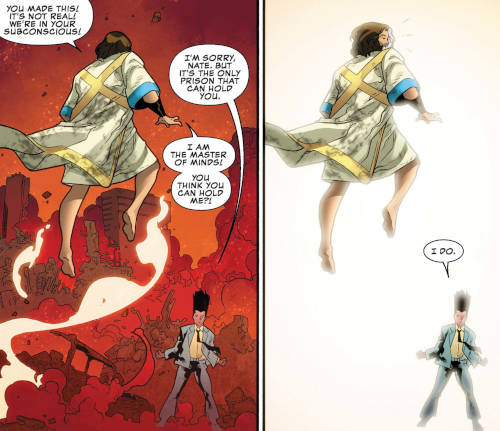 and Glob tried to protect him. Only when Hisako was beaten down and exhausted enough to try killing Nate herself did Bishop arrive to rescue them, with only five minutes having passed in the real world. Once Nate Grey realized where he truly was, the X-Man pitted his mind against Legion directly and won. The pocket reality vanished, and the X-Men found themselves facing two Omega-class mutants merged into a single powerhouse, with Nate Grey in control and no longer willing to listen to reason from anyone.
and Glob tried to protect him. Only when Hisako was beaten down and exhausted enough to try killing Nate herself did Bishop arrive to rescue them, with only five minutes having passed in the real world. Once Nate Grey realized where he truly was, the X-Man pitted his mind against Legion directly and won. The pocket reality vanished, and the X-Men found themselves facing two Omega-class mutants merged into a single powerhouse, with Nate Grey in control and no longer willing to listen to reason from anyone.
The furious X-Man was ready to destroy anyone who stood against him and forced Storm into his Horsemen of Salvation with a mere wave of his hand. Praising his own patience and benevolence, Nate Grey and his four over-powered allies managed to hold their ground, even as Jean Grey and Pixie gathered nearly every member of the X-Men on Earth to oppose them. He denounced the X-Men for being too scared to guide him and Legion properly, afraid of “their children” and their 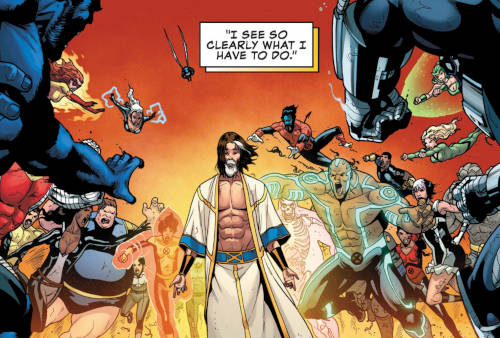 power. With the combined might of the X-Men’s telepaths and a newly-freed Storm distracting him, Jean managed to get inside Nate’s head. She made him feel the pain he had caused around the world. Nate recognized that this world would never accept his gifts, so he chose a new gift to bestow. Nate Grey said, “No More X-Men,” and wiped Quadra Island clean of all its combatants, seemingly killing himself and every X-Man with him. [Uncanny X-Men (5th series) #1-10]
power. With the combined might of the X-Men’s telepaths and a newly-freed Storm distracting him, Jean managed to get inside Nate’s head. She made him feel the pain he had caused around the world. Nate recognized that this world would never accept his gifts, so he chose a new gift to bestow. Nate Grey said, “No More X-Men,” and wiped Quadra Island clean of all its combatants, seemingly killing himself and every X-Man with him. [Uncanny X-Men (5th series) #1-10]
However, the Lifeseed remained with him. It could not save his life but it also couldn’t let him die. Nate Grey bonded even further with the Lifeseed’s power, becoming one with it as it guided him in creating an entirely new pocket reality to preserve him and the X-Men lost in his final conflict. Nate guided this universe through millions of years of accelerated growth and evolution, recreating history up until a certain point before establishing a new present. Nate wrote himself into the early history of the X-Men, effectively replacing Hank McCoy as a founding member of Xavier’s team. He was now a respected (if distant) veteran of the team, no longer remembered as a cocky kid with an attitude and a leather jacket.
Next, Nate diverted the normal course of history with a final crisis that pitted the X-Men against 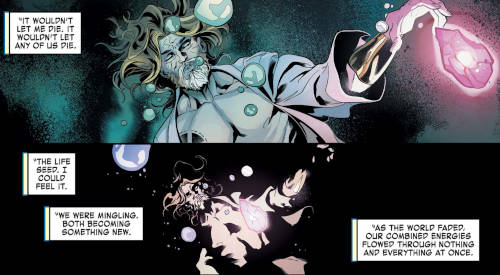 Stryfe and Mister Sinister. Many prominent X-Men (those who weren’t present on Quadra Island) reportedly died in this conflict, including Xavier, Cyclops, Wolverine, Rogue, Gambit, Cable, Quicksilver, Scarlet Witch and more. The final sacrifice came when Hope Summers reportedly used the Lifeseed to imbue everyone on Earth with the X-gene, bringing an end to the age of humanity and the rise of mutantkind, an event known as the Resolution. With the deaths of Hope and the villains, society emerged as a utopia where everyone lived in peace and harmony.
Stryfe and Mister Sinister. Many prominent X-Men (those who weren’t present on Quadra Island) reportedly died in this conflict, including Xavier, Cyclops, Wolverine, Rogue, Gambit, Cable, Quicksilver, Scarlet Witch and more. The final sacrifice came when Hope Summers reportedly used the Lifeseed to imbue everyone on Earth with the X-gene, bringing an end to the age of humanity and the rise of mutantkind, an event known as the Resolution. With the deaths of Hope and the villains, society emerged as a utopia where everyone lived in peace and harmony.
Or so they were told. Nate Grey also chose to impose his own philosophy on society, known as the Guiding Principles, which everyone remembered as being championed by the great savior Hope before her sacrifice. The X-Man combined memories from the human shaman Nate Grey 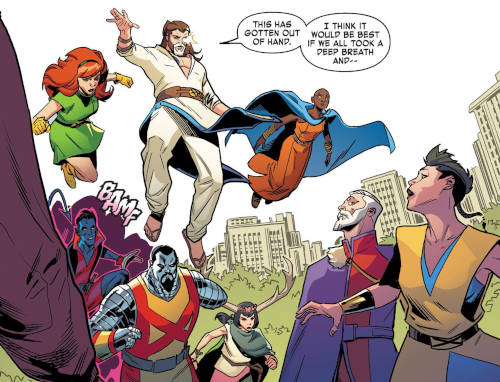 with his own feelings of abandonment and isolation from the mutant community, creating an ideology of the individual. New mutants in this society were only born as Nate was, through artificial-engineered crèches called Cerebro. It was considered “more evolved” to move beyond personal relationships and focus solely on the self, so ideas of romantic love and family connections were consigned to the past. Identity. Autonomy. Harmony. These were the new foundation for society.
with his own feelings of abandonment and isolation from the mutant community, creating an ideology of the individual. New mutants in this society were only born as Nate was, through artificial-engineered crèches called Cerebro. It was considered “more evolved” to move beyond personal relationships and focus solely on the self, so ideas of romantic love and family connections were consigned to the past. Identity. Autonomy. Harmony. These were the new foundation for society.
But while Nate and the Lifeseed could implant memories of everyone accepting the Guiding Principles, they could not alter basic human nature so easily. People still sought companionship and love, even knowing it was now forbidden and “retrograde.” Nate empowered a secret police of “civil management” called Department X to hunt down ‘Grades who violated the Principles, 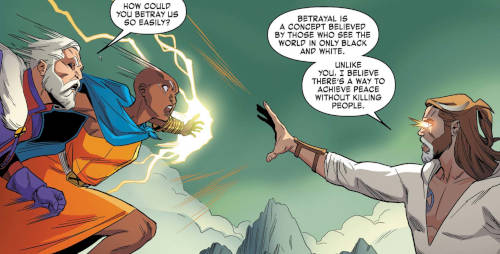 papering over these violations so the public never knew. Mind wipes were common but, after a third violation, people were condemned to secret prisons like the Danger Room which even the X-Men were unaware existed. Nate would even remove X-Men like Bishop from the roster for violations, then re-write everyone’s memories as if he had never been a member of the team.
papering over these violations so the public never knew. Mind wipes were common but, after a third violation, people were condemned to secret prisons like the Danger Room which even the X-Men were unaware existed. Nate would even remove X-Men like Bishop from the roster for violations, then re-write everyone’s memories as if he had never been a member of the team.
Department X also helped the X-Men feel useful in this pacifist utopia by secretly setting forest fires and orchestrating excuses for people to cheer for their heroes. The hidden tyranny of this society was so integrated into false and distorted memories, it doesn’t seem as if Department X even knew who they reported to or who was in charge of the Principles. Nate Grey’s puppet work went so deep that he actually organized and oversaw the resistance to his own utopia. Nate used the Lifeseed to program Apocalypse into acting as a counter-culture revolutionary to his ideals. Thus was born Murshid En Sabah Nur, preaching free love from his X-Tracts as his Light Riders championed outdated ideals of personal affection. Nate wanted to see how his X-Men would respond to this challenge to the Guiding Principles.
This universe was not stable, however, leading to fissures opening up in reality, which provided glimpses back to the real world. Many times, X-Men or others saw memories they had forgotten or lives not lived, only for Nate to come along and patch over their memories and the holes in reality  again. It was a constant effort from the X-Man to prevent people from remembering the past, while keeping them committed to the future he wanted for them. As he lost control and his patchwork reality began to fail, the people Nate manipulated began to gather against him. Nate was surprised to see Dani Moonstar among the escaped prisoners from the Danger Room, since she hadn’t been on Quadra Island. Nate’s past relationship with Dani was so strong, he had subconsciously recreated her in his new world.
again. It was a constant effort from the X-Man to prevent people from remembering the past, while keeping them committed to the future he wanted for them. As he lost control and his patchwork reality began to fail, the people Nate manipulated began to gather against him. Nate was surprised to see Dani Moonstar among the escaped prisoners from the Danger Room, since she hadn’t been on Quadra Island. Nate’s past relationship with Dani was so strong, he had subconsciously recreated her in his new world.
As their memories were restored, the X-Men rejected Nate’s Guiding Principles. His ideas about autonomy only bred isolation and loneliness. Humankind were social creatures who thrived on love and community, and the “pain” from personal relationship did not outweigh the benefits. The need for a secret police to constantly impose commitment to these Principles against people’s will 
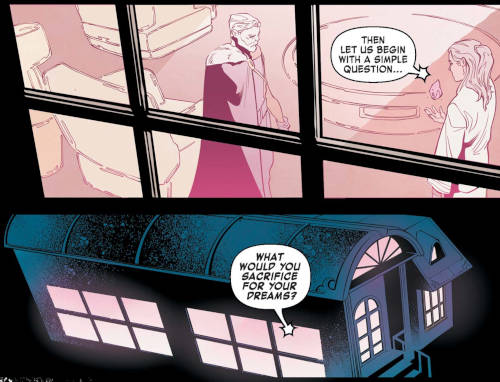 only highlighted how unnatural and unsustainable such a society was. Nate remained self-righteous in his commitment to these ideals, but he would no longer force them upon the X-Men. They used the fissures to return to their home reality, leaving Nate in isolation with those mutants he created, who had never known any other sort of life. In the last moments, Magneto and Nate used the Lifeseed to create a copy of Magneto’s “Age of X-Man” doppelganger to remain behind with the X-Man, working together to create a new and more principled version of reality. [Age of X-Man crossover]
only highlighted how unnatural and unsustainable such a society was. Nate remained self-righteous in his commitment to these ideals, but he would no longer force them upon the X-Men. They used the fissures to return to their home reality, leaving Nate in isolation with those mutants he created, who had never known any other sort of life. In the last moments, Magneto and Nate used the Lifeseed to create a copy of Magneto’s “Age of X-Man” doppelganger to remain behind with the X-Man, working together to create a new and more principled version of reality. [Age of X-Man crossover]
